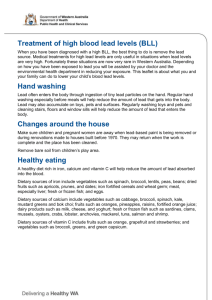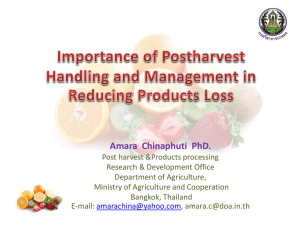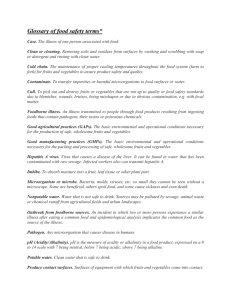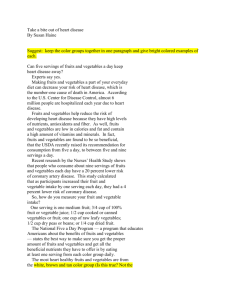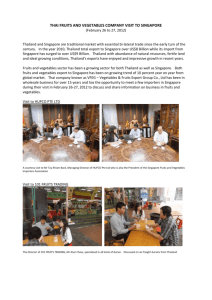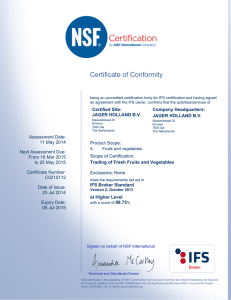Status of Fruits & Vegetables Production and Processing in NER
advertisement
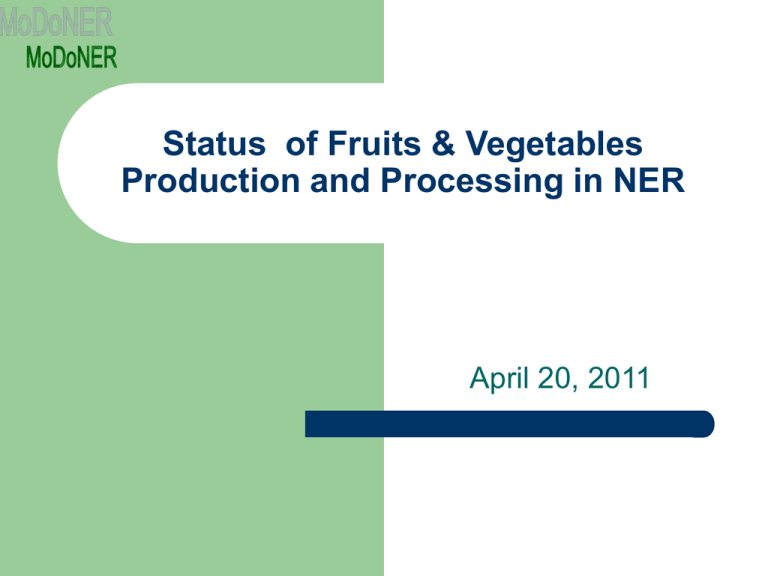
Status of Fruits & Vegetables Production and Processing in NER April 20, 2011 Agenda Overview Production of Fruits & Vegetables Huge Wastage Constraints Thrust areas Supportive policies of GoI Basic Parameters of Good Food Processing Industry Policy Discussions Overview Food is the largest consumption category in India India produces 9% of world’s fruits and 11% of World’s Vegetables However, only 2% of fruits and vegetables in India are processed Huge wastages, estimated at about 35%, the value of which is approx. Rs.33,000 Rs. 33,000crore croreannually annually Despite strong raw material base India is unable to tap potential for processing and value adding in perishables like fruits and vegetables Area and Production of Fruits & Vegetables 2009-10 in NER Area in '000' Ha Production in ‘000’ MT STATE/UT’S FRUITS Area VEGETABLES Production Area Production ARUNACHAL PRADESH 72.0 107.90 4.20 38.50 ASSAM 117.30 1575.50 255.20 4569.90 MANIPUR 38.40 281.90 19.90 221.80 MEGHALAYA 32.90 294.80 44.30 415.80 MIZORAM 27.10 328.30 10.60 179.10 NAGALAND 30.80 223.70 10.40 78.30 SIKKIM 12.20 18.50 28.70 147.70 TRIPURA 36.90 573.80 32.50 446.90 TOTAL 367.70 3404.40 405.80 6097.90 TOTAL ALL INDIA 6329.20 71515.50 7984.80 133737.60 SOURCE: NATIONAL HORTICULTURE BOARD, GOVT. OF INDIA Production of Fruits 2009-10 Production in ‘000’ MT STATE/UTs ARUNACHAL PRADESH BANANA CITRUS GUAVA PAPAYA 107.9 223.0 114.0 1575.5 103.5 98 281.9 5.6 106.8 56.5 294.8 20.3 6.3 29.3 328.3 6.8 80.1 28.9 223.7 2 18.5 117.5 296.6 573.8 170.3 671.6 650.0 3404.4 3913.5 1386.8 27531.2 71515.5 805.2 225.9 88.2 MANIPUR 33.7 46.7 0.0 MEGHALAYA 82.8 43.1 0.0 MIZORAM 207.7 64.7 62.7 43.7 1.5 3.2 13.1 0.1 105.6 33.9 1.7 18.5 1314.3 506.8 91.5 26469.5 9638.0 2571.5 SIKKIM TRIPURA TOTAL TOTAL ALL INDIA TOTAL 24.7 35.6 NAGALAND OTHERS 34.4 13.3 ASSAM PINEAPPLE 119.1 SOURCE: NATIONAL HORTICULTURE BOARD, GOVT. OF INDIA Production of Vegetables 2009-10 Production in ‘000’ MT STATE/UTs CABBAGE C.FLOWER TOMATO 31.7 0.0 0.0 0.0 0.0 6.8 38.5 589.7 614.2 351.3 379.5 253.0 2382.2 4569.9 15.2 72.8 22.9 27.2 0.0 83.6 221.8 221.7 0.0 0.0 0.0 0.0 194.1 415.8 MIZORAM 20.9 44.4 107.2 179.1 NAGALAND 10.0 3.0 0.2 4.0 2.2 59.0 78.3 SIKKIM 44.3 7.0 3.9 4.1 1.6 86.8 147.7 TRIPURA 99.4 42.6 27.6 29.6 38.9 208.9 446.9 1032.8 783.9 405.9 451.1 295.8 3128.5 6097.9 36577.3 7281.4 6569.0 12433.2 10563.0 60313.6 133737.6 ARUNACHAL PRADESH ASSAM MANIPUR MEGHALAYA TOTAL TOTAL ALL INDIA POTATO BRINJAL 6.7 OTHERS TOTAL SOURCE: NATIONAL HORTICULTURE BOARD, GOVT. OF INDIA Food Processing Sector in India Huge wastage across the supply chain leads to lower level of processing and hence low value addition… Field Losses (Pest,Diseases, Rodents etc) Level of Processing across Segments Segment Pre-Processing (e.g. inefficient harvesting, drying, milling) Transport (e.g. spillage, leakage) Storage (e.g. technical deficiencies) Processing & Packaging (e.g. excessive peeling, washing) Marketing (e.g. spoilage, rotting in stores) Wastage by Consumer (e.g. over eating, food wastage) India Fruits and Vegetables 2.2% Marine 26% Poultry 6% Other Countries US A (65 %), Philippines (78%) China (23)%; 60-70% in developed countries Buffalo Meat 20% Milk 35% 60-75% in developed countries Perceived Constraints Low incomes and high share of basic foods in household consumption. Socio-cultural factors – Preference for freshly plucked fruits. Low productivity, high wastage. Inadequate infrastructure for sorting / grading / packing. Lack of trained manpower for processing storage, marketing, branding. APMC Act which restricts sourcing materials from farmers. Lack of common policy on Contract Farming. Low access to credit to farmers. Inability to attract investment by large corporate houses due to unreliable sources of supply of raw material. Thrust areas Enhanced income of farmers Increased level of processing of perishables from 6% to 20% Increased value addition from 20% to 35% Increased share in global food trade from 1.5% to 3% in next 15 years Promote dynamic/competitive food processing industry Achieve integration of food processing infrastructure from farm to market Have transparent and industry friendly regulatory regime Supportive Policies of GoI 1 NEIPP 2007 for industry including Food Processing Industry 2 Transport Subsidy Scheme and Horticulture Mission for NE & Himalaya States 3 Development of products and processes for secondary agriculture, food industry and bio-processing sectors 4 Infrastructure Development and Technological Upgradation 5 Quality Control / R&D, H.R & Institutional Development Felt needs in NER Promote Nutrition Foods Processable variety of Crops Support Backward Integration Increase Promotional Activities Market Access to Farmers Investment in Hard/Soft Infrastructure Technology Upgradation Harmonisation of Taxes Discussion to follow: Preparation of action plan – identify fruits and vegetables with potential for food processing in specific North East States / Areas. How to promote agro based / food processing sector in NER – put in place a model supply chain by bringing in farmers, traders, processors, extension machinery and R&D Institutes together. Amendments (if required) in existing policies – in NEIPP 2007, TSS 1971, to promote the agro based sector/industries. How to attract investment including FDI in the sector. Suitability of for autonomous industry driven boards for individual crops. Need for preferential treatments / liberalising excise regime / reducing excise duties of Centre / States for individual products such as Pineapple in Tripura. Ultimately ? Can our discussion lead to a strategy which is not fragmented Ministry / Scheme wise but encompasses all aspects of a dynamic food processing sector in NER ?

